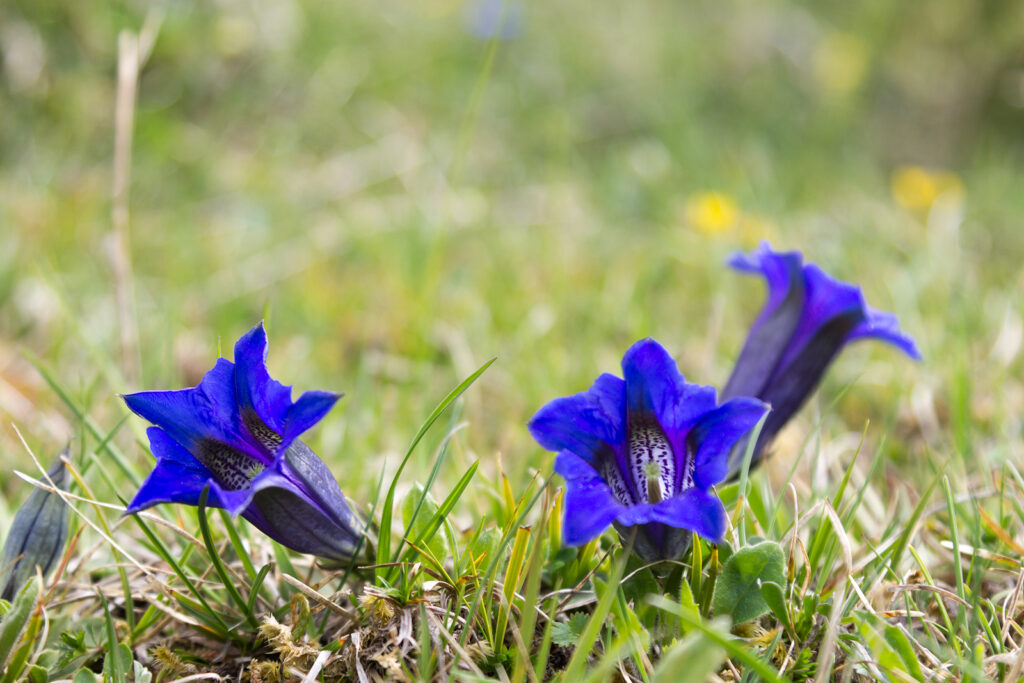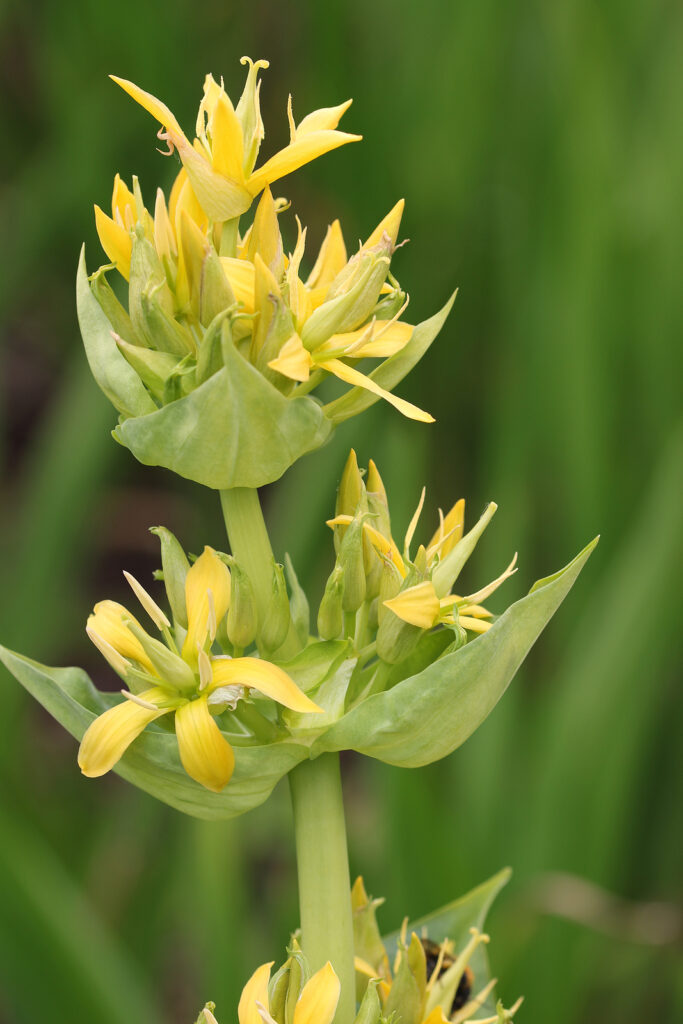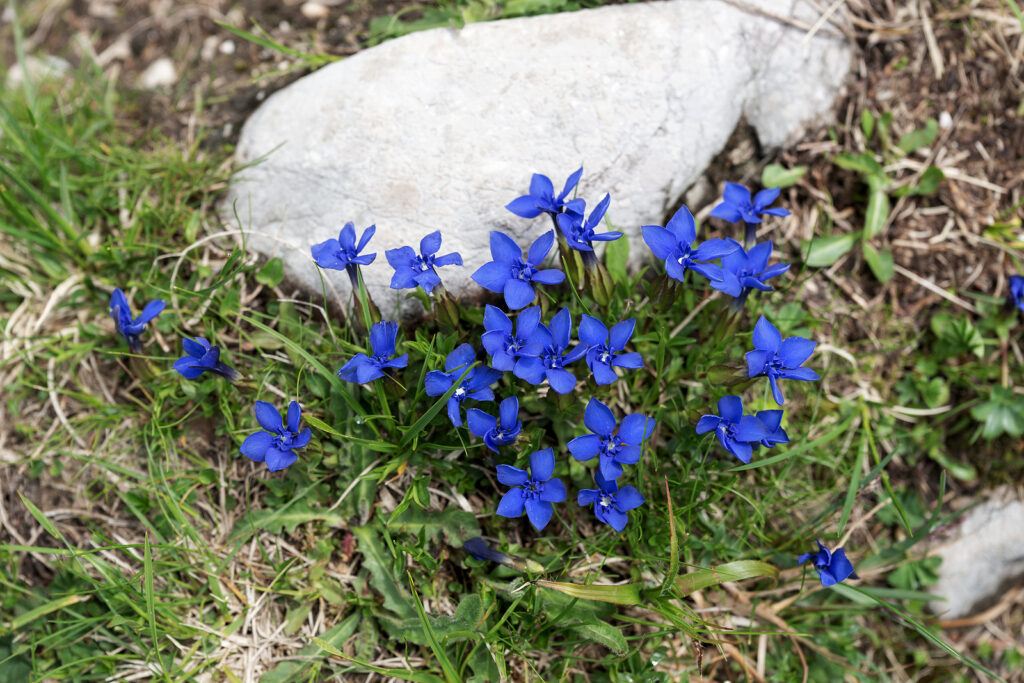Gentiana, commonly called Gentian, are commonly grown for their rich shades of true blue flowers, but there are some gentians in shades of violet, yellow, white, and red. Gentiana are perennials; many are grown in beds and borders, very small species are prized by rock garden enthusiasts.
Most, but not all, Gentiana can be difficult to grow. They need perfect drainage, and most require lime-free soil. When they thrive, they produce some of the richest blues in the garden.
Gentiana have simple, often lance-shaped leaves and carry their trumpet- or bell-shaped flowers singly or in clusters. Depending on the species, blooms appear anywhere from spring to fall.
Gentiana is a genus of about 400 species of hardy annuals, biennials, and perennials, which may be deciduous, semi-evergreen, or evergreen. Most gentians are native to alpine habitats and are suitable only for areas that have cool summer, such as the Pacific Northwest. A few species can be grown successfully over a wider area.

Get to know Gentiana
- Plant type: Perennial
- Growing zones and range: Zones 5 to 9
- Hardiness: Hardy to Zone 5
- Height and width: 18 to 20 inches (45-50cm) tall and half as wide, some smaller and some as tall as 5 feet (1.5m)
- Foliage: Simple leaves borne in oppostie pairs along stems
- Flowers: Large usually trumpet-shaped, sometimes bell-shaped fowers, mainly intense blue but also in white, yellow and occasionally red.
- Bloom time: Spring to autumn
- Uses: Borders, small species in rock gardens
- Common name: Gentian
- Botanical name: Gentiana
- Family name: Gentianaceae
- Origin: North America, Japan
Where to plant Gentiana
- Plant Gentiana in full sun.
- Plant Gentiana in light, humus-rich moist but well-drained soil.
When to plant Gentiana
- Set container-grown Gentiana in the garden in spring or autumn.
Planting and spacing Gentiana
- Space Gentiana 8 to 12 inches (20-30cm) apart.
How to water and feed Gentiana
- Keep the soil evenly moist with regular water; Gentiana prefers moist, well-drained soil.
- Fertilize Gentiana with an all-purpose, slow-release organic fertilizer in spring.

Gentiana care
- Gentiana can be difficult to grow. Plants need perfect drainage and lime-free soil.
Gentiana pests and diseases
- Gentiana is susceptible to rust and Cercospora leaf spots.
- Slugs and snails can cause damage to Gentiana.
- Aphids and spider mites can attack Gentian grown indoors.
Gentiana propagation
- Sow seeds of Gentiana in containers in an open frame as soon as ripe.
- Divide Gentiana or root offsets in spring.

Gentiana varieties to grow
- Gentiana acaulis. Small plant with leafy stems to 4 inches tall. Rich blue flowers 2 inches long in summer. Grows well, but often fails to bloom.
- G. andrewsii. Closed gentian, bottle gentian. Easy to grow clump-forming plant grows to 24 inches tall; dark green leaves; clusters of urn-shaped dark blue 1 ½-inch-long flowers clustered at top of the stem and in joints of upper leaves; blooms late summer or early fall. Flowers are usually fully closed, sometimes only partially closed.
- G. asclepiadea. Willow gentian. Similar to G. andrewsii, but the 1 ½-in. dark blue trumpet-shaped flowers open into stars; flowers appear singly or in twos or threes in joints of upper leaves, in late summer or early fall; appears as arching, leafy spikes of blue flowers. Not difficult to grow. ‘Alba’ is a white form.
- G. clusii (G. acaulis clusii). Similar to G. acaulis, but with larger flowers.
- G. lutea. Yellow gentian. Erect, clump-forming perennial grow to 5 feet tall; has strongly ribbed blusih green leaves; clusters of yellow flowers are borne in midsummer.
- G. septemfida. Crested gentian. Arching or sprawling stems 9 to 18 inches long. Clusters of 2-inch dark blue flowers in late summer; oval leaves to 1 ½ in. long. Easy to grow. G. s. lagodechiana has sprawling stems that turn up at tips to display flowers at branch tips and among upper leaves.
- G. sino-ornata. Trailing stems grow from 7-inch rosettes of bright green leaves; 2-inch-long bright blue flowers appear at stem ends in early fall. Fairly easy to grow in half shade.
- G. verna. Spring gentian. Mat-forming plant 1 ½-4 inches tall; dark blue, 1-inch flowers appear singly on short stems in spring. Difficult, fragile plant. Needs some lime.















